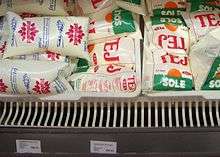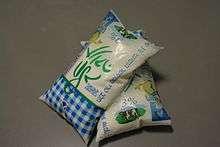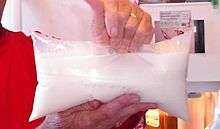Milk bag

Milk bags are plastic bags that contain milk. They are usually stored in a pitcher or jug with one of the corners cut off to allow for pouring. A typical milk bag contains approximately 1 L (1.8 imp pt) of milk in South America, Iran, Israel, Eastern Europe and the Baltics, while in the UK they contain 2 imperial pints (1.1 L), in Canada 1 1⁄3 litres (2.3 imp pt), and in India,0.5 L (0.9 imp pt).[1]
Usage



Milk bags are popular in the Baltics (e.g. Estonia) and some Eastern European countries, where they may also be seen used for packaging yogurt or kefir. A resurgence of milk bags is beginning in Britain amid concerns that plastic bottles are not being recycled. Milk bags were used in Australia (Greater Shepparton, Victoria), in the late 1990s, distributed by Shepparton-based dairy company Ducats. They were also used in Gympie, Queensland, in the 1970s and early 1980s, and also in Caboolture, Queensland around the same time. These were 1 pint in size.
Dairies in the United States used the bags in the 1980s, but today are confined mainly to regional convenience store chains with in-house dairies such as Kwik Trip in the Upper Midwest and other boutique dairies.
In Israel, milk in a bag is the most common type of packaging for milk. They became the standard form of milk packaging in the 1960s, with the discontinuation of glass bottles. In Israel, the milk bag is a regulated product, which means that its price is controlled by the state. Therefore, there are price differences between the milk bags and the other alternatives available for marketing milk - plastic bottles or milk cartons. Due to the price differences, a relationship was observed between the socioeconomic status of the consumer and the type of milk tank that they customarily purchased. The higher the socio-economic status of the purchaser, the more likely they are to buy milk in cartons rather than in bags, despite the higher price of the first. Network Blue Square created based on these differences a way to measure the status socioeconomic status of the area based on the ratio of the number of purchased milk cartons and the number of bags of milk purchased. The higher the ratio of the former to the latter, the higher the status of the region in Israel.[2] For religious Jews, opening a bag of milk can be considered problematic on Shabbat , because the action requires cutting. Israel's interior minister has used empty milk bags in the Knesset, as props to complain about price-hikes in the cost of milk.[3]
In the United Kingdom, Sainsburys began a pilot experiment on distributing milk in bags in 2008 in conjunction with Dairy Crest.[4] It was originally targeted at 35 stores at the same price as a regular 2-imperial-pint (1.1 l) plastic bottle of milk,[5] the product was expanded through the North of England nationwide in 2010 at which point the bags retailed at a discounted price compared to traditional containers.[6] In the UK, the bags are usually used in conjunction with a specialized plastic jug. The bag fits snugly inside the jug, one corner of the bag is secured under a bar at the front of the jug, and as the lid is closed the bag is pierced and a spout slides into the hole, allowing the milk to be easily poured and maintaining freshness. Doorstep deliveries in the United Kingdom are normally associated with traditional glass milk bottles, but the Dairy Crest/Milk and More service also deliver milk bags, and sell Jug-It brand plastic jugs specially designed to hold the milk bags.
In Mexico, assistance programs and prior welfare and government social programs distribute milk in bags (1 l (1.8 imp pt) per bag) at very low prices.[7]
In urban parts of India, milk is most commonly sold in ½-litre and 1-litre bags.
In Australia, they are referred to as 'Scrabble Bags'.
Milk bags are also commonly used in Colombia, Ecuador, Argentina, Brazil, Uruguay,[8] Israel[9], Russia and South Africa.[10]

Bagged milk is common in many parts of Canada. The innovation was introduced in 1967 by DuPont using European equipment. The new packaging quickly found favour with the domestic dairy industry, being lighter and less fragile than glass bottles. However, the consumer public preferred plastic jugs for years, but largely accepted the new containers in certain regions in the 1970s. A major reason for that shift was with the national conversion to the metric system, which was easier to adjust to on production with bags while doing the same for jugs required entire systems to be wholly redesigned.[11] Milk bags are also referred to as milkwutters by Canadians in the region of British Columbia. They are sold in eastern Canada, but not widely in western Canada (Manitoba, Saskatchewan, Alberta and British Columbia).[11] Three bags are sold together in a larger bag containing a total of 4 L (7 imp pt) of milk. The bags are not sold individually, and are either not labelled at all or labelled with only the expiry date, the lot number and sometimes the type of milk contained in the bag. The three-bag 4 L (7 imp pt) package is the largest normally sold at retail, with the lowest unit price. Some convenience store chains offer 4 L (7 imp pt) plastic jugs instead of milk bags, even in eastern Canada. Two accessories are commonly associated with Canadian milk bags: pitchers and bag openers. The key-shaped bag opener with a clip and a magnet was invented in Toronto in 1979.[12] These bag openers are a common type of refrigerator magnet, although the bags can be opened with scissors or knives.
Benefits

The principal benefits of bagged milk are economic. For producers, it is easier to vary portion size when sealing bags than cartons, as well as lowering the cost of packaging. Milk bags also take up less space in garbage. For consumers, bags typically allow for smaller portion sizes, reducing the risk of spoilage.[13]
Drawbacks
When pouring, the top of the bag can turn over, causing the milk to spill. Spillage can be avoided by cutting a secondary hole at the other side of the bag for air intake, by pinching the top of the bag while pouring, or by using a pitcher with a lid to keep the milk bag in place. Milk bags cannot easily be sealed once open, although some consumers fold over the spout and use clips to help maintain freshness. Also, a common single-ply LDPE bag is easy to pierce and tear, and must be handled and transported with care to avoid product losses and messes.
Environmental concerns
While milk bags use less plastic than the traditional jug, there is no incentive on consumers to recycle the bags, such as the refunds provided when jugs are recycled at a bottle depot.[14] In Canada, where recycling services are municipally or regionally managed, milk bags may not always be able to be recycled. In some municipalities milk bags are required to be thrown away[15] and in others they are recyclable.[16]
See also
References
- ↑ Washburn, Devin; Sumar, Sai. "What's up with Bagged Milk?". Lucky Peach. Lucky Peach. Retrieved 2 August 2016.
- ↑ On the relationship between buying milk and socioeconomic status Orna Yefet Published: 08.12.03
- ↑ Knesset Eli Yishai raised gallon of milk to protest the price hike, Ynet , January 31, 2005
- ↑ Blades, Hollye (2008-06-09). "Pinta goes green as supermarkets offer shoppers the chance to buy milk in a bag". The Times. London.
- ↑ Neate, Rupert (2008-06-09). "Milk in bags hits Sainsbury's shelves". The Daily Telegraph. London.
- ↑ Wallop, Harry (2010-02-24). "Milk in a bag at Sainsbury's". The Daily Telegraph. London.
- ↑ SEDESOL, Liconsa (2012-04-27). "Liconsa". Sedesol. Mexico.
- ↑ Chertoff, Emily (2012-08-01), "The Surprising History of the Milk Carton", The Atlantic, The Atlantic, retrieved 2015-08-26
- ↑ "Buying milk in a bag in Israel – and remembering when I first realized the beauty of travel". www.chicagonow.com. Retrieved 2016-05-31.
- ↑ "Lausanne Milk Products". www.lausannedairies.co.za. Retrieved 2017-01-06.
- 1 2 Kelly, Cathal (2010-02-04). "So we drink milk from bags. Does that make us weird?". Toronto Star. Retrieved 2014-01-20.
- ↑ "The Snippit". Tangibles Ltd.
- ↑ Nosowitz, Dan (2015-10-20). "What's The Point Of Milk That Comes In Plastic Bags?". Modern Farmer. Retrieved 2015-10-22.
- ↑ "Calgary Recycling at Bottle Depots". Calgary.foundlocally.com. Retrieved 2015-11-02.
- ↑ "City of Ottawa - Recycling and Garbage - Milk Bags". App06.ottawa.ca. Retrieved 2015-11-02.
- ↑ http://www.peterborough.ca/Assets/City+Assets/Waste+Management/Documents/2+Stream+Recycling+List.pdf
External links
![]()
- Milk Bags Demystified A woman demonstrates the nature of the packaging and how it is readied for use.